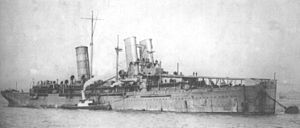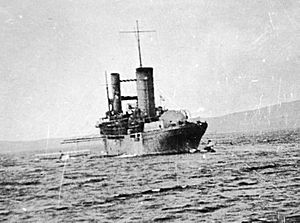HMS Campania (1914) facts for kids

HMS Campania after her second refit
|
|
Quick facts for kids History |
|
|---|---|
| Name | HMS Campania |
| Builder | Fairfield, Glasgow, Scotland |
| Laid down | 1892 |
| Launched | 8 September 1892 |
| Acquired | 27 November 1914 |
| Commissioned | 17 April 1915 |
| Fate | Sank in the Firth of Forth, 5 November 1918 |
| General characteristics | |
| Type | Aircraft/Seaplane carrier |
| Displacement | 20,570 long tons (20,900 t) |
| Length | 622 ft (189.6 m) |
| Beam | 65 ft (19.8 m) |
| Draught | 28 ft 5 in (8.7 m) |
| Installed power | 28,000 ihp (21,000 kW) |
| Propulsion | 2 × shafts, 2 × 5-cylinder VTE steam engines |
| Speed | 19.5 kn (36.1 km/h; 22.4 mph) |
| Complement | 600 |
| Armament |
|
| Aircraft carried | 10–12 |
| Aviation facilities | 1 × flying-off deck forward |
HMS Campania was a special kind of ship called a seaplane tender and aircraft carrier. She started out as an old ocean liner (a large passenger ship). The Royal Navy changed her into a warship early in the First World War.
After her changes were finished in mid-1915, Campania spent her time doing tests and training with the main British fleet, called the Grand Fleet. These tests showed that she needed a longer flight deck so bigger planes could take off. So, she was changed again to make her deck longer.
Campania missed the big Battle of Jutland in May 1916. But she did go on many patrols with parts of the Grand Fleet. She never actually fought in a battle. Soon, she was used only for training because her engines were old. In November 1918, Campania was anchored with other big ships of the Grand Fleet. A sudden storm made her anchor move. She didn't have a second anchor down, so she crashed into several other ships. These crashes made holes in her side, and she slowly sank. Luckily, no one was hurt.
Campania as a Passenger Ship
Before she was a warship, Campania was built in 1893 as a passenger ship for the Cunard Line. She carried people between Liverpool, England, and New York, USA. She was very fast and even won the Blue Riband award for speed early in her career.
By October 1914, she was getting old and worn out. She was sold to a company called Thos W Ward that breaks up old ships.
Becoming an Aircraft Carrier
The Royal Navy bought Campania from the shipbreakers on November 27, 1914. They paid £32,500 for her. At first, they planned to turn her into an armed merchant cruiser. This meant she would have eight fast-firing 4.7-inch guns.
But instead, the ship was changed into an aircraft carrier by a company called Cammell Laird. The two front 4.7-inch guns were removed. In their place, a flying-off deck was added. This deck was about 160 feet long.
Two derricks (like cranes) were put on each side of the ship. These were used to lift seaplanes from the water onto the ship and back again. The ship had two storage areas (called holds) for planes. The middle hold could hold seven large seaplanes. The front hold, under the flight deck, could hold four small seaplanes. But to get to these planes, the flight deck had to be lifted off. HMS Campania officially joined the navy on April 17, 1915.
The first time a plane took off from her flight deck was on August 6, 1915. It was a Sopwith Schneider floatplane (a plane that lands on water). It was placed on a wheeled trolley. The plane used about 130 feet of the deck while the ship was moving into the wind at 17 knots (about 20 miles per hour). This Sopwith plane was the lightest and most powerful plane the Royal Naval Air Service had. Even with a good wind, it was a close call. This showed that heavier planes couldn't take off from this deck.
By October 1915, Campania had trained with the Grand Fleet seven times. But she had only launched planes three times. This was because the North Sea was often too rough for her seaplanes to land on the water. Her captain suggested making the flying-off deck longer. He also thought it should have a steeper slope. This would let gravity help speed up the aircraft.
So, the ship was changed again at Cammell Laird. This happened between November 1915 and early April 1916. The front smokestack (funnel) was split into two. The flight deck was extended between them and over the bridge. It became 245 feet long. This meant planes from both storage holds could use the flight deck. A canvas screen was added. This allowed planes to unfold their wings out of the wind. A kite balloon and its equipment were also added in the back hold.
Now, Campania carried seven Short Type 184 torpedo bombers. She also had three or four smaller fighter or scout planes. A Type 184 plane made its first takeoff from the flight deck on June 3, 1916. It also used a wheeled trolley. This success made the Admiralty (the navy's leaders) order the world's first aircraft designed for carrier operations. These were called the Fairey Campania. The ship got the first of these planes in late 1917. They joined smaller Sopwith 1½ Strutter scout planes. At different times, Campania also carried the Sopwith Baby and Sopwith Pup planes.
Campania did not get the signal to leave when the Grand Fleet sailed from Scapa Flow on May 30, 1916. This was when they were heading to the Battle of Jutland. But she left two hours and fifteen minutes later. Even though she was slowly catching up to the fleet on the morning of May 31, she was told to go back to Scapa Flow. This was because she didn't have an escort ship, and German submarines had been seen in the area.
The ship did take part in some patrols to find submarines and German airships (Zeppelins). But later, she was declared not fit for main fleet duty. This was because her engines were old and not working perfectly. She then became a training ship for seaplanes and a base for balloons. In April 1918, Campania and the Grand Fleet moved from Scapa Flow to Rosyth.
The Sinking of Campania
Lua error in Module:Location_map at line 420: attempt to index field 'wikibase' (a nil value).
On the morning of November 5, 1918, Campania was anchored near Burntisland in the Firth of Forth. A sudden, very strong storm (a Force 10 squall) hit. This caused the ship's anchor to drag along the seabed.
She first crashed into the front (the bow) of the nearby battleship Royal Oak. Then, she scraped along the side of the battlecruiser Glorious. The first crash with Royal Oak made a hole in Campania's side. Water flooded her engine room, and all her main electricity shut down.
The ship then started to sink by her back end (the stern). She sank about five hours after she broke free from her anchor. All the crew members were saved by other ships nearby. A Naval Board of Inquiry (a formal investigation) looked into what happened. They said that Campania's watch officer was mostly to blame for her loss. They specifically pointed out that he failed to drop a second anchor when the ship started to drift.
The remains of HMS Campania on the seabed were given special protection in 2000. This protection was changed in 2013. The site is now a Historic Marine Protected Area. The remains of four Campania aircraft and seven 1½ Strutter planes that were on board when she sank are still inside her wreck.



